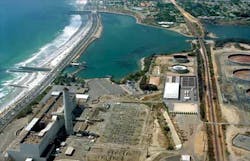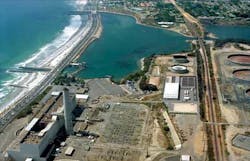In San Diego County, water comes from only a handful of places: the Colorado River in northern California or from water rights purchased from farmers in the Imperial Valley. In order to diversify its portfolio and secure a locally controlled, drought-proof water supply, the San Diego County Water Authority (SDCWA) turned its attention to desalination.
"What better drought-proof source than the pacific ocean?" said Peter MacLaggen, senior vice president of project development for water infrastructure project development firm Poseidon Resources. "It's the largest reservoir in the world and it's not dependent upon snowpack or local precipitation."
After 12 long years of planning, development, litigation, negotiation, and permitting, the last key milestone of discretionary approvals for the 50 MGD Carlsbad Desalination Project was achieved when SDCWA's 34-member board approved a 30-year water purchase agreement that will, by 2020, supply 7 percent of the region's water needs.
What's particularly noteworthy about the $900 million project is the public-private partnership that made it possible.
The project is being financed by a combination of debt ($734 million) and private equity ($167 million). MacLaggen explained that the debt for the project comprises all private bonds. There are two tranches: roughly $500 million is for the plant; $234 million is for the 10-mile-long pipeline to connect the plant to the Water Authority's delivery system, which is San Marcos 10 miles east of the plant site.
The private activity bonds are issued through a conduit agency in Sacramento, the California Water Pollution Control Finance Authority. "The agency is a public entity that issues private activity bonds and so they are state and federal tax exempt," MacLaggen explained. The credit for that debt issuance is the water purchase agreement. "Poseidon Resources is obligated to retire the debt, not the water authority," he said. "So there is no risk to the public agency of a default on the bonds. They're not obligated to pay the debt service."
The pipeline's financing is similarly structured. While Poseidon is the owner of the plant, the water authority is the owner of the pipeline. "But there's still non-recourse debt on the pipeline that Poseidon is obligated to pay for it," MacLaggen said. "So if we're delivering water to the water authority's aqueduct and they are making payments to us, then they also pay the debt on the pipeline."
If for whatever reason Poseidon comes up short and doesn't deliver some or all of the water that's supposed to be delivered, then the debt service on the pipeline is Poseidon's obligation, not the Water Authority's.
"This addresses a concern that the water authority had," he said, "which is that we could fail in our obligations and then they would be stuck paying for a pipeline that has no utility to them. So they wanted to make sure all the risk of success of this project was squarely placed on the private sector partner."
If you distill the roles and responsibilities of the parties down to their simplest terms, the private partner (Poseidon) has to develop, design, engineer and construct the plant and deliver water into the Water Authority's system, meeting quantity and quality specifications. "And if we do, that's when we get paid," MacLaggen said. "That's when the Water Authority's obligation kicks in and they pay for the unit price of each acre foot of water delivered."
Under the 30-year water purchase agreement, the Water Authority buys all of the output of the plant at a predetermined price. "That price depends on how much water they buy, but right now ranges from $1,850 to roughly $2,000 an acre foot in current dollars," he said. Going forward, that number is linked to inflation. "There's a Consumer Price Index and then electricity is paid for based on Poseidon taking consumption risk and the water authority taking tariff risk," he said.
"So if the local utility raises the tariff price then the Water Authority pays whatever that new tariff rate is and based on our guaranteed consumption levels," he explained.
After the tenth year of operation, the Water Authority has the right to purchase the plant for a price based on a predetermined formula. "And after the 30th year, if they haven't bought the plant yet, the Water Authority has the right to acquire the plant for $1 if they want to exercise that option," he added.
"After 12 years of development, it's exciting to be in a position where we can move forward with this important water supply opportunity for San Diego County," MacLaggen said.
"The Water Authority's approval last November and the financing that followed truly is a historic milestone for Southern California water supply," he said. "It's going to forever change the way that San Diegans look at the Pacific Ocean and their water supply. It's going to forever change the way California looks at the Pacific Ocean as a resource."
Desalination is an option that, until now, has been too expensive. At the same time, traditional supplies have been cheap and plentiful. "But neither of those is the case any longer," said MacLaggen. "I think everybody is looking at Carlsbad as, pardon the pun, a bit of a 'sea change' in how we look at water in the state of California."
The project is expected to take 35 months. "In October 2015," MacLaggen said, "we should be completing the performance tests and headed to commercial operations."
The Work Ahead
An engineering project of this magnitude requires a highly specialized team of experts. To execute this, two renowned firms - Kiewit Infrastructure and JF Shea Construction - formed a joint venture called Kiewit-Shea Desalination.
Established in 1884, Kiewit is one of the largest general contractors in North America, consistently ranked among the top 10 contractors by Engineering News Record. In 2010, the company's revenues were almost $10 billion.
JF Shea, founded in 1881, started as a small plumbing business. Today, it's grown into one of the largest privately held builders in the nation, having worked on both the Golden Gate Bridge and the Hoover Dam.
Kiewit Shea Desalination has retained IDE Americas Inc., a subsidiary of Israeli firm IDE Technologies, to provide the desalination technology component. IDE Technologies already has its equipment in the two of the largest desalination plants in the world, Ashkelon and Hadera in Israel.
Ready and Able
IDE Technologies offered the following comments on its involvement in the Carlsbad Desalination Project:
The Carlsbad project has been a long-standing project for IDE Technologies and Poseidon.
We have worked with Poseidon for the last seven years through some ups and downs, but with determination and faith in the success of this project. It is rewarding to see that we are now moving forward.
Focused on desalination, we have managed to provide the best, most suitable technology for the changing conditions. For example, we've been able to improve the cost structure of this project by reducing the footprint and energy consumption, as well as introducing other technological advancements in the pretreatment phase. These improvements have helped to proceed with the project.
IDE brings years of experience in addressing desalination with other successful large-scale projects all over the world, especially in India, China, Australia and the Middle East. Backed with our vast experience and being the technology provider for the Carlsbad project, we believe IDE is positioned as a market leader in the U.S. desalination industry. This market will continue to develop during the upcoming years and we look forward to the new opportunities.
WaterWorld Articles Archives





